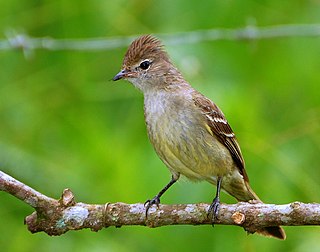
The yellow-bellied elaenia is a small bird in subfamily Elaeniinae of family Tyrannidae, the tyrant flycatchers. It is found in Mexico, in every Central American country, in every mainland South American country except Chile, on Trinidad and Tobago, and on several islands in the Lesser Antilles.

The southern beardless tyrannulet is a small passerine bird in subfamily Elaeniinae of family Tyrannidae, the tyrant flycatchers. It is found in Costa Rica, Panama, in every mainland South American country except Chile, and on Trinidad.

The mountain elaenia is a small passerine bird in subfamily Elaeniinae of family Tyrannidae, the tyrant flycatchers. It is found in Colombia, Costa Rica, El Salvador, Guatemala, Honduras, Nicaragua, Panama, and Venezuela.

The white-crested elaenia is a species of bird in subfamily Elaeniinae of family Tyrannidae, the tyrant flycatchers. It is found in Bolivia, Chile, Colombia, Ecuador, and Peru.

The lesser elaenia is a species of bird in subfamily Elaeniinae of family Tyrannidae, the tyrant flycatchers. It is found in Costa Rica, Panama, on Trinidad, in every mainland South American country except Chile and Uruguay, and as a vagrant on Bonaire and Curaçao.
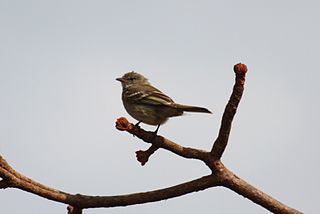
The plain-crested elaenia is a species of bird in subfamily Elaeniinae of family Tyrannidae, the tyrant flycatchers. It is found in Bolivia, Brazil, Colombia, French Guiana, Guyana, Peru, Suriname, and Venezuela.

The great elaenia is a species of bird in subfamily Elaeniinae of family Tyrannidae, the tyrant flycatchers. It is found in Brazil and Venezuela.

The mottle-backed elaenia is a species of bird in subfamily Elaeniinae of family Tyrannidae, the tyrant flycatchers. It is found in Bolivia, Colombia, Ecuador, and Peru.

The highland elaenia is a species of bird in subfamily Elaeniinae of family Tyrannidae, the tyrant flycatchers. It is found in Argentina, Bolivia, Ecuador, and Peru.

The slaty elaenia is a species of bird in subfamily Elaeniinae of family Tyrannidae, the tyrant flycatchers. It is found in Argentina, Bolivia, Colombia, Peru, and Venezuela, and as a vagrant in Ecuador and on Trinidad.

The white-throated tyrannulet is a species of bird in subfamily Elaeniinae of family Tyrannidae, the tyrant flycatchers. It is found in Argentina, Bolivia, Brazil, Colombia, Ecuador, Peru, and Venezuela.

The white-banded tyrannulet is a species of bird in subfamily Elaeniinae of family Tyrannidae, the tyrant flycatchers. It is found in Bolivia, Colombia, Ecuador, Peru, and Venezuela.

The yellow-crowned elaenia is a species of bird in subfamily Elaeniinae of family Tyrannidae, the tyrant flycatchers. It is found in Brazil, Colombia, Ecuador, French Guiana, Guyana, Peru, Suriname, and Venezuela.

The foothill elaenia is a species of bird in subfamily Elaeniinae of family Tyrannidae, the tyrant flycatchers. It is found in Colombia, Ecuador, Peru, and Venezuela.

The Pacific elaenia is a species of bird in subfamily Elaeniinae of family Tyrannidae, the tyrant flycatchers. It is found in Ecuador and Peru.
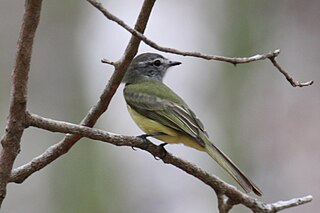
The greenish elaenia is a species of bird in subfamily Elaeniinae of family Tyrannidae, the tyrant flycatchers. It is found in Mexico, every Central American country, and every mainland South American country except Chile and French Guiana. It has also occurred as a vagrant in southern Texas.

The slender-footed tyrannulet is a species of bird in the family Tyrannidae, the tyrant flycatchers. It is found in humid forests of the west Amazon Basin in Venezuela, Colombia, Ecuador, Peru, Bolivia and Brazil. Until recently, it included the Guianan tyrannulet as a subspecies.
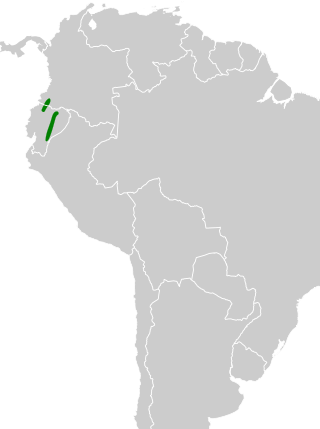
Coopmans's elaenia is a species of bird in subfamily Elaeniinae of family Tyrannidae, the tyrant flycatchers. It is found in Colombia and Ecuador.

The tepui elaenia is a species of bird in subfamily Elaeniinae of family Tyrannidae, the tyrant flycatchers. It is found in Brazil, Guyana, and Venezuela.
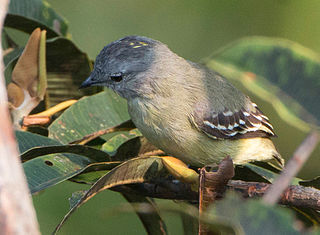
The Amazonian elaenia or Amazonian grey elaenia is a species of bird in subfamily Elaeniinae of family Tyrannidae, the tyrant flycatchers. It is found in every mainland South American country except Argentina, Chile, Paraguay, and Uruguay, though there is only a single sight record in Suriname.























